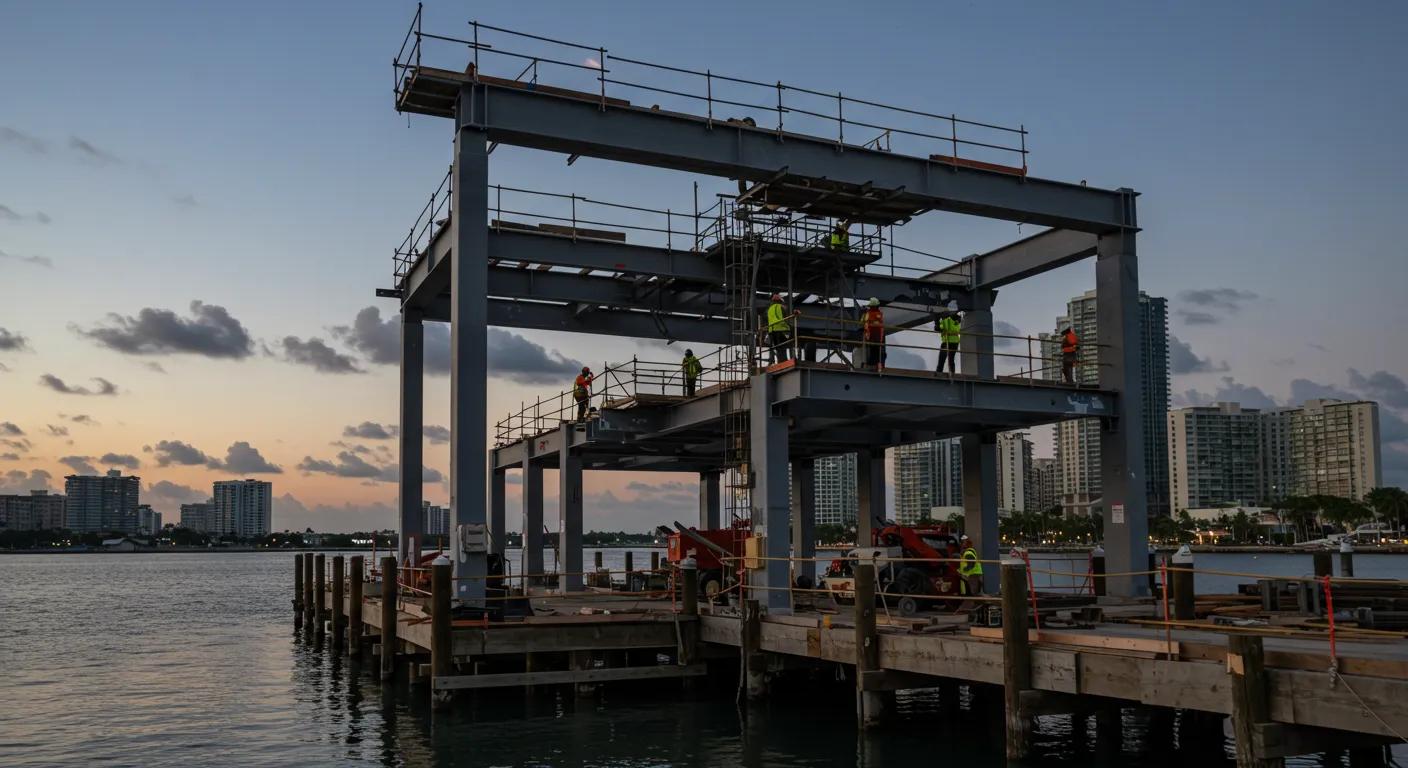Are Your Dock Safety Standards Up to Code?
In the world of waterfront construction and dock operations, safety is not merely a procedural requirement—it is essential for protecting assets, employees, and overall business sustainability. Over the decades, stringent measures have evolved to address the complex challenges of dock construction, maintenance, and operation. This article emphasizes why dock safety compliance matters from legal and operational perspectives and explains how adherence can improve efficiency, reduce financial risks, and foster strong relationships with regulatory bodies and clients.
In the sections that follow, you will learn about the key regulations affecting dock safety compliance and the consequences of failing to meet these standards. We explore the safety protocols provided by organizations such as OSHA and the International Maritime Organization and review the benefits of a compliant dock infrastructure. Additionally, the article highlights common hazards, offers practical training solutions, and explains effective monitoring and maintenance of compliance. With a professional and friendly tone and actionable insights, this guide is tailored for homeowners and construction professionals who want to ensure that their docks and maritime facilities meet the highest codes.
Understand the Impact of Meeting Dock Safety Standards
Meeting dock safety standards lays the foundation for a safe, efficient, and productive waterfront operation. Compliance minimizes the risk of accidents that may lead to severe injuries, costly litigation, or even fatalities. Robust safety practices reduce occupational hazards and protect valuable cargo. For example, strictly following guidelines on personal protective equipment (PPE) and fall protection can significantly lower workplace injuries, benefiting both construction workers and dock employees.
Key regulations affect all aspects of dock safety—from load capacity to the proper handling of hazardous materials. When these standards are met, they not only foster a secure work environment but also improve project timelines and operational reliability. Each safety measure enhances physical protection while contributing to a culture of responsibility and compliance. Moreover, adhering to safety standards can reduce insurance premiums and offer a competitive edge in tenders and contracting opportunities, ultimately supporting the long-term viability and reputation of your maritime operations.
Learn Key Dock Safety Standards for Compliance

Understanding and learning the key dock safety standards is critical for risk management and operational success. One principal set of guidelines comes from the Occupational Safety and Health Administration (OSHA), which covers safety practices on loading docks including fall protection, proper use of forklifts, secure scaffolding, and correct application of PPE. Compliance with OSHA not only avoids legal penalties but also guarantees a secure work environment. For example, OSHA requires barrier systems and safety nets that reduce the risk of falls on elevated platforms.
In addition to OSHA, international standards set by the International Maritime Organization (IMO) are pivotal. These standards include safety measures for navigation, handling, and storage of dangerous goods, plus requirements for flood management and coastal safety. IMO guidelines are especially important for docks exposed to rapidly changing weather and sea conditions.
An effective dock safety program also incorporates detailed risk assessment procedures. Regular inspections and audits help identify issues such as worn-out equipment, malfunctioning lifts, or structural weaknesses. Continuous risk assessments ensure compliance despite evolving standards. Additionally, the maintenance of equipment like cranes, forklifts, and other heavy machinery is crucial; even minor misalignments or rust can have significant operational consequences. By following these guidelines, dock operators build a safer and more efficient workspace that meets regulatory requirements and builds trust among employees and clients.
Recognize Benefits of Compliance With Dock Safety Standards
Compliance with dock safety standards offers clear benefits that justify investments in safety equipment, training, and maintenance programs. First, improved safety protocols increase operational efficiency. With hazards minimized, there is less downtime due to accidents or repairs, which leads to a more streamlined workflow and enhanced overall productivity.
Moreover, compliance boosts employee morale and job satisfaction. When workers feel safe and valued, they are more motivated to adhere to best practices, reducing turnover rates and cultivating a culture that values employee well-being. Financially, adherence to safety standards minimizes the risk of accidents and liability claims—saving costs related to lawsuits and insurance premiums while reinforcing a reputation as a trusted partner in waterfront construction.
In addition, meeting safety standards helps foster better relationships with regulatory bodies and clients. Transparent, consistent adherence to safety protocols keeps you in good standing with inspectors and authorities and can be a decisive factor during contract bids or permit applications. Companies that are known for meeting and exceeding safety standards often secure better financing terms and are viewed as industry leaders, offering long-term competitive advantages.
Discover Common Dock Safety Hazards to Address

Identifying and addressing common dock safety hazards is a critical, proactive measure to save lives and reduce liabilities. One major hazard is associated with the loading and unloading of cargo. Improperly handled or unstable cargo can lead to serious accidents, especially when combined with the movement of heavy vehicles like forklifts. Securing cargo properly and ensuring balanced weight distributions are essential strategies to mitigate these risks.
Another significant hazard involves collisions between vehicles and pedestrians. Docks are busy environments where heavy machinery and personnel often interact. To reduce such risks, it is essential to establish clear traffic management protocols, designate specific pedestrian walkways, and enforce separation protocols between vehicle lanes and pedestrian zones.
Hazards also arise from improper handling of hazardous materials. If these materials are not correctly identified and managed, they can result in chemical spills or harmful emissions. Regular training in handling and storing hazardous substances is therefore crucial.
Furthermore, the gradual degradation of dock infrastructure—such as corroded metal surfaces, worn lifting mechanisms, or poorly maintained railings—adds to the risk. Routine inspections and a documented maintenance process help catch and address these issues before they lead to failures.
Lastly, environmental factors like flooding or severe weather conditions can aggravate safety hazards. Docks in flood-prone areas or along the coast must have additional safeguards, including elevated structures and robust drainage systems, to mitigate the impact of natural elements. Being aware of these hazards and taking early corrective measures can substantially reduce both accidents and overall risk exposure.
Implement Effective Dock Safety Training Programs
Effective dock safety training programs are essential for equipping employees to handle the unique hazards inherent in dock operations. Comprehensive, targeted training is the first line of defense against accidents. A well-designed program goes beyond explaining safety protocols—it includes hands-on drills and practical exercises that mimic real-life scenarios.
Training should be based on a detailed analysis of the specific tasks performed on site. Key topics include the proper use of personal protective equipment (PPE), safe operation of forklifts and heavy machinery, and emergency response procedures for incidents like spills or equipment failure. For example, training sessions may include practical exercises in using fall protection harnesses, securing cargo, and conducting rapid evacuations.
Hands-on safety drills are particularly effective; they allow workers to simulate emergencies, test response times, and build muscle memory for critical procedures. Regular drills ensure that, in a true emergency, employees can act swiftly and correctly.
It is also vital to update training materials regularly. As safety standards evolve and new technologies emerge, training should reflect the latest best practices. Feedback from drills and assessments can help identify areas for improvement and ensure that training remains relevant and complete.
A culture of continuous learning should be fostered where safety is considered a collective responsibility. When employees understand not just what to do but why actions are necessary, they are more likely to adopt safe behaviors consistently. Ultimately, these training programs are key to minimizing human error and ensuring long-term operational excellence.
Monitor and Maintain Compliance With Dock Safety Standards

Continuous monitoring and maintenance of dock safety standards are essential for safe operations. A daily compliance checklist is a simple but effective tool to ensure every safety protocol is observed. Such a checklist should cover important aspects like equipment maintenance, proper use of PPE, and secure storage of hazardous materials, along with a record of routine safety inspections. Early identification of issues through such checklists prevents minor problems from escalating.
Regular audits, whether internal or by third-party experts, are critical to assess current safety practices. These audits verify that all operational areas—from loading docks to storage facilities—adhere to OSHA guidelines and related standards. Keeping a thorough audit record not only supports immediate safety compliance but also proves invaluable during regulatory inspections.
An efficient, systematic reporting process is also essential. Employees should be encouraged to report any potential hazards or non-compliance issues, even anonymously if needed, to ensure risks are addressed promptly. This reporting system should be linked with corrective and retraining measures to prevent recurring issues.
Staying informed about changes in regulatory standards is equally important. Both federal and international bodies periodically update safety guidelines based on new research or incident reviews. Regular review sessions, subscriptions to regulatory newsletters, or participation in professional safety organizations help ensure that dock operations remain aligned with the latest requirements.
By using daily checklists, scheduling periodic audits, and maintaining open safety reporting channels, you create a dynamic safety management system. This systematic approach not only improves operational efficiency but also strengthens your facility against potential hazards, providing a safe environment for employees and cargo while meeting evolving safety standards.
Frequently Asked Questions
Q: How do dock safety standards impact workplace efficiency? A: Dock safety standards enhance efficiency by reducing downtime from accidents, minimizing repair costs, and ensuring smooth operational flow. With fewer interruptions, employees can maintain a consistent and productive workflow.
Q: What are the most critical hazards on a dock, and how can they be mitigated? A: Critical hazards include cargo instability, vehicle-pedestrian collisions, hazardous material spills, and equipment deterioration. Mitigation strategies include securing cargo properly, establishing clear traffic lanes, rigorous hazardous material training, and frequent maintenance inspections.
Q: How often should dock safety training be updated to remain compliant? A: Training should be updated at least annually or whenever new regulatory standards are introduced or significant operational changes occur. Regular refresher courses and practical drills help maintain a high level of safety awareness.
Q: Can improved dock safety lead to financial savings for a business? A: Yes, enhanced dock safety reduces the risk of accidents, lowers insurance premiums, minimizes downtime, and decreases liability claims. A strong safety record can also boost customer confidence and yield long-term operational benefits.
Q: What are the key components of an effective dock safety audit? A: An effective audit includes reviewing daily checklists, inspecting PPE and maintenance records, evaluating hazard reporting procedures, and verifying compliance with OSHA and international safety standards. These audits ensure continuous safety improvements.
Q: How are regulatory bodies involved in dock safety compliance? A: Agencies like OSHA and the International Maritime Organization set and enforce safety standards for dock operations. They conduct inspections, issue penalties for non-compliance, and update guidelines based on industry research to ensure high safety standards.
Q: What role does employee training play in maintaining dock safety? A: Employee training is essential as it equips workers with the knowledge and skills to handle hazards, use equipment safely, and respond appropriately to emergencies. Continuous training reinforces a strong safety culture across all dock operations.
Final Thoughts
Ensuring that your dock safety standards are up to code is an investment that pays dividends in operational efficiency and employee well-being. Adhering strictly to regulatory guidelines, implementing thorough training programs, and maintaining ongoing monitoring create a safe and compliant work environment. Embrace these practices to reduce risks, lower costs, and improve the overall performance of your waterfront operations. Prioritize safety today to safeguard your business and secure long-term success.




